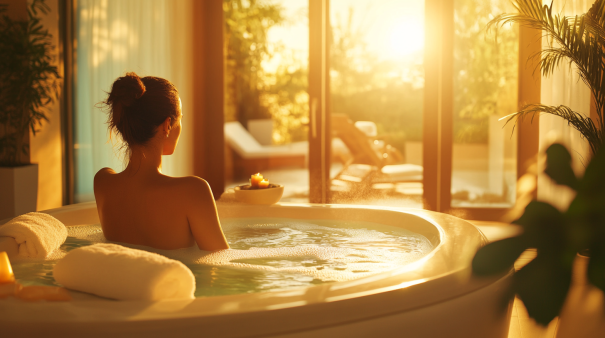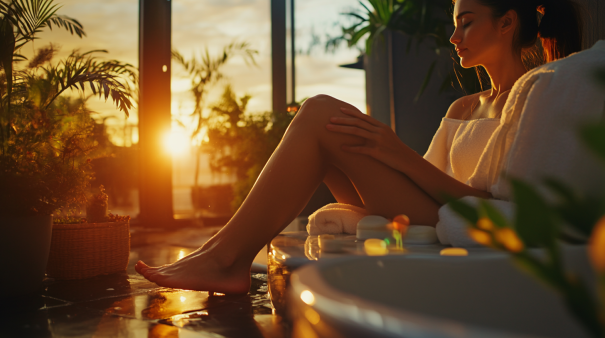In today’s fast-paced world, finding time to relax and unwind is essential for maintaining overall well-being. A home spa experience can provide the perfect retreat from daily stresses, offering a sanctuary for rejuvenation and self-care. With a few simple preparations and the right mindset, you can transform your home into a tranquil spa oasis. This article offers tips and ideas for setting up a spa-like atmosphere at home, complete with DIY treatments and relaxation techniques to help you relax and recharge.

Setting the Stage: Creating a Spa-Like Atmosphere
The ambiance is crucial in setting the tone for your home spa experience. By paying attention to the sensory elements—sight, sound, smell, touch, and taste—you can create an environment that promotes relaxation and well-being.
1. Declutter and Clean Your Space
A clutter-free and clean environment is the first step toward creating a calming atmosphere. Choose a space in your home where you can unwind without distractions, such as a bathroom, bedroom, or a cozy corner. Clear away unnecessary items, tidy up, and clean the area thoroughly. A neat space helps clear the mind and sets the stage for relaxation.
2. Soft Lighting
Lighting plays a significant role in creating a serene environment. Opt for soft, warm lighting instead of harsh, bright lights. Dim the lights or use candles to create a gentle, soothing glow. Flameless LED candles are a safe alternative to traditional candles and can provide a similar ambiance.
3. Aromatherapy
Aromatherapy uses essential oils to promote relaxation and enhance mood. Choose essential oils known for their calming properties, such as lavender, chamomile, or eucalyptus. Use an essential oil diffuser, a few drops in a warm bath, or a scented candle to fill your space with a relaxing aroma. Be mindful of any allergies or sensitivities to certain scents.
4. Soothing Sounds
Music and nature sounds can enhance the spa experience by creating a calming auditory environment. Choose relaxing music, such as soft instrumental or nature sounds like ocean waves, rain, or birdsong. You can find playlists on streaming services or use a sound machine designed for relaxation.
5. Soft Textures
Incorporate soft textures to enhance the sense of touch and add to the comfort of your space. Plush towels, cozy blankets, and soft robes can make your home spa experience more indulgent. Lay down a soft mat or rug if you’re using a bathroom, and consider adding some cushions or pillows to your relaxation area.
6. Refreshing Beverages
Hydration is an essential part of any spa experience. Prepare a selection of refreshing beverages, such as infused water with cucumber, lemon, or mint, or herbal teas like chamomile or peppermint. Drinking plenty of water helps detoxify the body and keeps you feeling refreshed.
DIY Spa Treatments: Pampering Yourself at Home
With the right ingredients and a bit of creativity, you can create a range of DIY spa treatments that rival those of professional spas. These treatments can help you relax, rejuvenate your skin, and nourish your body.
1. Facial Treatments
a. Cleansing
Start your facial with a thorough cleansing to remove makeup, dirt, and impurities. Use a gentle cleanser suitable for your skin type. For a deeper cleanse, consider steaming your face for 5-10 minutes by leaning over a bowl of hot water with a towel draped over your head. The steam opens up your pores, making it easier to remove impurities.
b. Exfoliation
Exfoliating helps remove dead skin cells, leaving your skin smooth and glowing. You can make a simple exfoliating scrub using natural ingredients. For example, mix a tablespoon of honey with a teaspoon of finely ground sugar or oatmeal. Gently massage the scrub onto your face in circular motions, then rinse with warm water.
c. Face Mask
Applying a face mask can nourish and hydrate your skin. Here are a few DIY mask ideas for different skin types:
- Hydrating Mask: Mix half a mashed avocado with a tablespoon of honey and apply to your face for 10-15 minutes. Avocado and honey are both deeply moisturizing.
- Clarifying Mask: Combine a tablespoon of yogurt with a teaspoon of turmeric powder. Yogurt contains lactic acid, which gently exfoliates, while turmeric has anti-inflammatory properties.
- Brightening Mask: Mix a tablespoon of lemon juice with a tablespoon of honey. Lemon juice can brighten the skin, and honey adds moisture. Be cautious with lemon juice if you have sensitive skin.
After applying the mask, relax and let it work for 10-20 minutes before rinsing off with warm water.
d. Moisturizing
Finish your facial by applying a moisturizer suited to your skin type. If desired, use a facial roller or gua sha tool to help the moisturizer absorb and reduce puffiness.
2. Body Treatments
a. Exfoliating Scrub
Exfoliating your body helps remove dead skin cells and promotes smooth, radiant skin. You can make a DIY body scrub using simple ingredients like sugar or salt combined with a carrier oil, such as coconut oil or olive oil. Add a few drops of your favorite essential oil for an extra spa-like touch.
Example Recipe:
- 1 cup sugar or salt
- 1/2 cup coconut oil
- 5-10 drops of essential oil (e.g., lavender, peppermint)
Mix the ingredients and gently massage the scrub onto damp skin in circular motions, focusing on rough areas like elbows, knees, and feet. Rinse off with warm water and pat dry.
b. Detox Bath
A detox bath can help relax muscles, relieve stress, and detoxify the skin. Add Epsom salts, which are high in magnesium, to your bathwater to soothe sore muscles. Baking soda can help neutralize acids and soften the skin. For added relaxation, include a few drops of essential oil.
Example Recipe:
- 1-2 cups Epsom salts
- 1/2 cup baking soda
- A few drops of essential oil (e.g., lavender, eucalyptus)
Soak in the bath for 20-30 minutes, then rinse off and moisturize.
c. Moisturizing Treatment
After exfoliating and bathing, apply a rich body moisturizer or oil to lock in hydration. Ingredients like shea butter, cocoa butter, and coconut oil are excellent for nourishing the skin. For an added spa touch, warm the moisturizer slightly before application.
3. Hair Treatments
a. Deep Conditioning Mask
Treat your hair to a nourishing deep conditioning mask to restore moisture and shine. You can make a simple hair mask using ingredients like coconut oil, olive oil, or avocado.
Example Recipe:
- 2 tablespoons coconut oil
- 1 tablespoon honey
- 1 mashed avocado
Mix the ingredients and apply them to damp hair, focusing on the ends. Leave the mask on for 20-30 minutes, then rinse thoroughly with warm water and shampoo.
b. Scalp Massage
A scalp massage can improve blood circulation, relieve tension, and promote hair health. Use your fingertips to gently massage your scalp in circular motions for 5-10 minutes. You can enhance the experience by using a few drops of essential oil diluted in a carrier oil, such as jojoba or coconut oil.
4. Hand and Foot Treatments
a. Hand and Foot Soak

Soaking your hands and feet can soften the skin and relax tired muscles. Prepare a basin of warm water with Epsom salts and a few drops of essential oil. Soak your hands and feet for 10-15 minutes, then dry thoroughly.
b. Exfoliating Scrub
Exfoliate your hands and feet using a scrub similar to the body scrub described earlier. Pay special attention to rough areas, such as heels and cuticles.
c. Moisturizing Treatment
Apply a thick moisturizer or hand and foot cream to lock in moisture. For an intensive treatment, wear cotton gloves or socks overnight to allow the product to absorb fully.
Relaxation Techniques: Enhancing Your Spa Experience
Beyond physical treatments, incorporating relaxation techniques can deepen your home spa experience, promoting mental and emotional well-being.
1. Deep Breathing
Deep breathing exercises can help calm the mind and reduce stress. Practice diaphragmatic breathing, where you inhale deeply through your nose, allowing your abdomen to rise, and then exhale slowly through your mouth. Repeat this for a few minutes, focusing on your breath.
2. Meditation
Meditation is a powerful tool for relaxation and mindfulness. Find a comfortable position, close your eyes, and focus on your breath or a calming mantra. If you’re new to meditation, guided meditations can provide helpful direction and structure.
3. Visualization
Visualization involves imagining a peaceful scene or place, such as a beach, forest, or garden. Use all your senses to fully immerse yourself in the experience, noticing the sights, sounds, smells, and sensations. Visualization can help reduce stress and promote a sense of calm.
4. Progressive Muscle Relaxation
This technique involves tensing and then relaxing different muscle groups in the body. Start with your toes and work your way up to your head, tensing each muscle group for a few seconds before releasing the tension. This practice can help relieve physical tension and promote relaxation.
5. Journaling
Journaling is a therapeutic activity that allows you to express your thoughts and feelings. Spend some time writing about your day, your thoughts, or anything that’s on your mind. This practice can help clear your mind and provide a sense of release.
Conclusion
Creating a relaxing home spa experience is a wonderful way to practice self-care and enhance your overall well-being. By paying attention to the sensory elements of your environment, using DIY treatments, and incorporating relaxation techniques, you can transform your home into a sanctuary of tranquility and rejuvenation. Whether you set aside a full day or just a few hours for your spa retreat, taking time for yourself is an investment in your health and happiness. Remember, the goal is to relax, unwind, and enjoy the moment, making your home spa experience a cherished part of your self-care routine.
